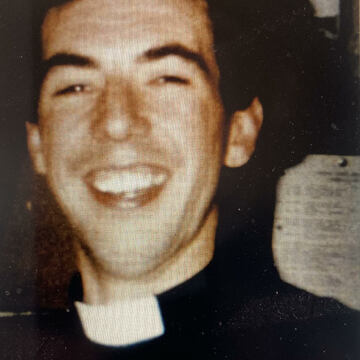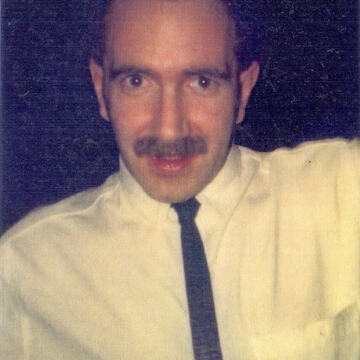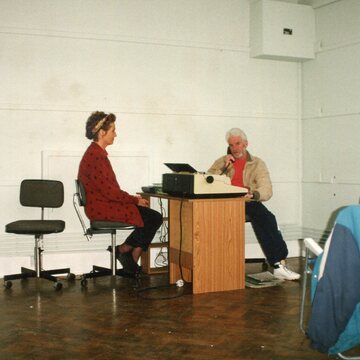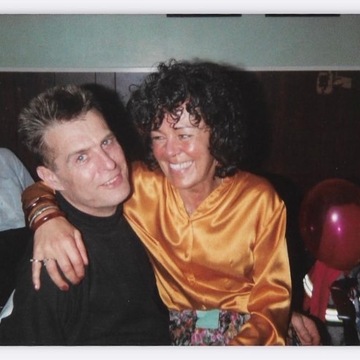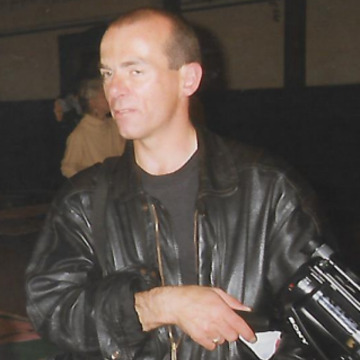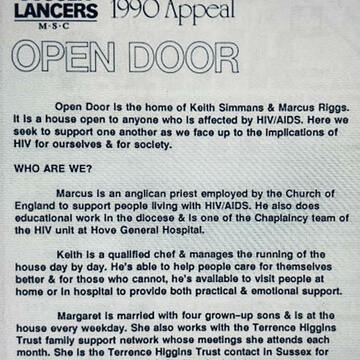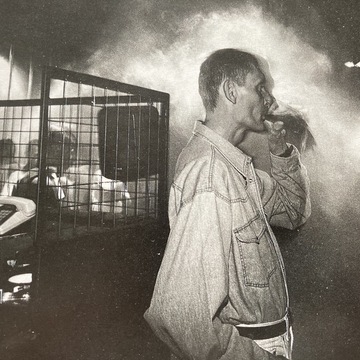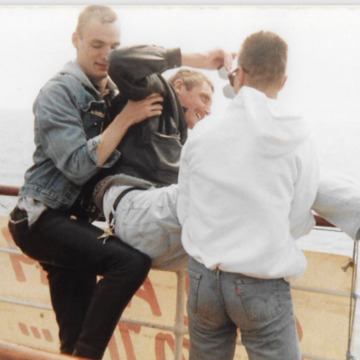Search results
-
Father Marcus Riggs (1955 – 10 July 1998) When I met Father Marcus Riggs for the first time, the man dressed in full biker leathers was completely unexpected, and I immediately felt the presence of someone quite unique. Marcus wasn’t the kind of human being who just passes through life, instead he lived it to the full, and made a profound impact on those he encountered along the way. When he took up his first Brighton ministry, he lived in the basement flat of the vicarage at St. Michael’s Church. He was soon working at the First Base Day Centre for the homeless, and it was perhaps this experience that inspired him to try to establish a drop-in centre for those diagnosed with HIV in the city. In the early days, all Marcus could offer was peer support to those who needed it from his flat, so he took the decision to make his home an ‘open door.’ And as a result of his persistent lobbying, determination, and refusal to keep quiet, Marcus eventually managed to persuade the Chichester Diocese to fund a day centre in Brighton, and in 1988, Open Door was born at 35 Camelford Street in Kemptown. Despite pressure to do so, Marcus never used Open Door as an opportunity to evangelise, because he believed he’d been ‘sent as one who serves,’ and that people could see good and God in the work. Marcus had an architectural background which proved useful as 35 Camelford Street was in a poor state, with everything needing to be done from scratch in more ways than one. Running the project demanded every ounce of Marcus’s energy but from the start he was helped by a wonderful team of volunteers. Word quickly spread, and it wasn’t long before Open Door was established as the place to go for peer support, understanding, companionship, a listening ear, benefits advice, alternative therapy, and great food. Visits to Open Door always centred around the dining table, and it was this atmosphere that made it feel like home to the many who passed through its doors. When the first specialist HIV ward (6) opened at Hove General Hospital on Sackville Road in 1990, Marcus was an obvious choice for chaplaincy. It was here that he offered spiritual and emotional support to many, including my friend Andrea in his last days. Father Marcus was one of a kind, admired by many and loved by everyone. He died from AIDS illness on the 10 July 1998, and a funeral oration and requiem mass was held at St Augustine’s in Brighton. He was buried at the Bear Road cemetery. In 2009, the Chichester Diocese stopped supporting Open Door, but all was not lost. The great work established by Father Marcus continued when Gary Pargeter, who worked as a chef at Open Door, set up Lunch Positive in 2010. Today this amazing grass roots charity provides a welcoming, safe, and supportive space for people to meet, socialise, make friends, share a healthy meal, and get peer support. The services provided by Lunch Positive have continued to be accepting, non-judgemental, inclusive, and put together and provided by people with HIV for the community, so I’m sure Marcus will be smiling and happy to see his legacy so beautifully maintained.
-
Gary Beverley Gary Beverley was my second partner and the first to die from AIDS. We met on a Saturday in April 1988 at the Bulldog where I was celebrating my 21st birthday. I can still picture it clearly and hear ‘Heaven is a place on earth’ playing, loudly! At the time, I was an aspiring clone, and Gary, 11 years older, had fully achieved clone status! I was drawn to his seductive smile, sparkling blue eyes, humour, wonderful laughter, tight fitting 501’s and perfectly polished DM’s. A five-year relationship began, and we were living together within months. Gary introduced me to new friends and experiences, and started my rapid exploration as a Gay man. It was exciting to share the Brighton Gay scene and beyond with Gary, but we also saw the fear and prejudice of HIV. Each year we lost more friends, saw more diagnosed, and then watched them quickly become seriously unwell, frail and die. Our relationship wasn’t always easy, but I never stopped loving Gary’s animated charm, and before AIDS progressed, his independent spirit. By 1992 Gary’s health had deteriorated and everyone commented on his weight loss and appearance. On a hot summer day in July, we both tested for HIV already knowing the results deep down. Gary had started showing signs of AIDS-related dementia, and the wonderful bright, vivacious, and independent man I loved quickly deteriorated with awful symptoms and eventually total loss of capacity. I’m sure others recall how distressing AIDS-related dementia was. I spent every day with Gary, right up to his death, willingly and wholeheartedly there as the awful disease rapidly progressed and diminished his mind and body. Throughout, he had occasional glimmers and signs of recognition, smiles and shared laughter, an outstretched hand for love and affection, and almost until the last moment, still cried out for me ‘my Gary.’ We were fortunate to be supported by loving close friends, Open Door, wonderful nurses & professionals, and so many others with HIV who stood with us in solidarity. I will always love Gary (tearful now) and remember the massively different time of HIV and AIDS, which for those who survived has been entirely life changing. Words by Gary Pargeter - 2021
-
Our House Body Positive valued the services offered by Open Door which was open weekday daytimes, but it was felt there was a need for a peer led service operating at weekends. The very first meeting took place in January 1991 at a Hereford Court flat on Lavender Street, and for the first six months the group met in people’s homes where a Sunday lunch would be cooked by the host, supported by other members of the group. After six months we were able to use a social services family centre building (now demolished) in Ivory Place, off Morley Street for our Sunday lunches. This gave us use of a fully equipped commercial kitchen, and sufficient space to expand. The group was a varied mix of male, female, varied ethnicities, straight, gay, positive and untested supporters which allowed people of different backgrounds to get to know each other and to support one another. The management of the building would not allow us to use their plates, cups or cutlery, so we had our own which we took to and from the centre each Sunday. The larger space allowed us to have themed discussions or a speaker after lunch each week, and the room to invite a variety of complementary therapists to offer their services (something that I managed). As the group grew along with its ambitions, we realised that a more organised structure was needed, so one Sunday we held a group workshop to explore what this might entail alongside things like a constitution and named officers. Some of our early active members (including Steven Chartwell and David Lambourne) disagreed with this development and felt it was time to leave the group. The experience of the Sussex AIDS Centre and Helpline locally and larger national groups made some people wary of ‘creeping corporate bureaucracy’. In early Spring 1993, we were able to lease a small suite of two rooms, kitchenette and toilets above the old fruit and vegetable market in Circus Street, and appointed Paul Overton (pictured in Circus Street) as our first salaried Chair. This allowed us to expand our services and the support we could provide, but we could no longer have Sunday lunches, so the anarchic homely nature of the group began to change. Around this time ‘Our House BP’ with its homely logo, changed its name to Brighton Body Positive. Although this was a clearer name which no longer required explanation, it came without the ownership implied in ‘Our’, or the homeliness implied in ‘House’. In 2006 the group moved to Community Base on Queens Road, but by then it’s identity as a self-help group had completely changed to a professional organisation beholden to the demands of its funders (social services, local council, etc). Several years later around 2010 it finally closed its doors. For a couple of years, it’s archive was kept in a portacabin at the Sussex Beacon, but sadly this has since been lost. Jim Stanford
-
Paul Theobald had already been diagnosed HIV+ when we met and became good friends. He lived just opposite the Sussex AIDS Centre and Helpline (SACH) with his partner Terry Morgan, and I lived nearby. Paul was worried that there were no weekend services for people with HIV, so he decided to start group meetings at his flat on a Wednesday. Back then SACH had a telephone helpline seven nights a week and a buddying service staffed by volunteers like me. There was also a small BP group, but volunteers were not allowed to go unless invited. I was fortunate enough to be invited alongside a paid worker we called ‘mother.’ Open Door provided lunch Monday to Friday and I cooked vegetarian food there every Tuesday. Paul’s meetings were popular because he was very charismatic, and soon something bigger was needed, so Sunday lunches were started in different homes each week, alternative therapies were introduced, and it wasn’t long before Our House Body Positive was born in 1992. Paul had it registered as a charity and premises above the old fruit & veg market in Circus Street were found. Paul was the first Chair we had, and I started fundraising with bric-a-brac stalls in the summer. I remember one Easter we put an advert in the Evening Argus for unwanted bits & pieces. I went down to Paul’s flat early one Saturday after stopping to buy 30 bunches of daffodils with our own money. We then drove all over to the homes of people who’d donated, and as people gave us their items, we wished them Happy Easter and gave them daffodils as a thank you. Paul worked very hard for OHBP and after a while it started affecting his health, so he stepped down. After his relationship with Terry ended, he decided to move back to London into a ground floor Flat in Islington where I visited a couple of times. His health improved, and he was soon back to the Paul we all knew. Sadly, we lost touch until 2004 when he phoned me to say he'd like to come to Brighton for a few days if I promised not to tell anyone. He said he'd let me know when he was coming, but alas that's the last I heard of him.
-
I met Shaun at a Body Positive Group meeting at the Sussex AIDS Centre and Helpline (SACH) which I’d been extremely privileged to be invited to. We also met sometimes at Open Door where he sometimes went for lunch. Shaun was a quiet person who kept himself to himself most of the time, but he could be quite outspoken if he felt something was wrong. He was helped a great deal by his partner Nick who was a volunteer at SACH and always very smartly dressed. Shaun was a regular at the Bulldog pub but didn’t talk much about his personal life. Words by Avee Tsofa Holmes
-
Sussex Lancers Open Door appeal 1990. Father Marcus Rigg’s partner Keith Simmans was a member of the Sussex Lancers, a gay men’s motorcycle club. The appeal is dated 1990. The photograph of 35 Camelford Street , the former location of Open Door, was taken by Harry Hillery in 2021.
-
Tall Ken in his own words - 1993 “I was diagnosed by a doctor who did the test without telling me. It was about 8 or 9 years back. I’ve lost touch with exactly when. I know it was June but that’s all I can remember. I had to decide whether or not to tell my mum and dad. I felt that in the end it would be more of a shock if anything were to happen to me and they found out that way. So, I did tell them. My mum had guessed something was wrong. She said, “you’ve got it haven’t you?” and the next thing I heard was the phone smashing against the wall, and her screaming down the phone “He’s got it! He’s got it!” Ever since then I’ve had a lot of support from my family. We were told not to talk about it because of the way the press was handling it then, but I decided to be open about it and tell everyone right from the start. I wasn’t rejected by anyone, so I was lucky. I do get bouts of depression now & again, but instead of letting AIDS and HIV suffocate me, I suffocate it. Most people who were diagnosed at the same time as me are gone now. When Open Door started, there were about ten of us. I think I’m the only one of them left now. It does make you think that the list is getting shorter and that your name is getting nearer the top. When I was diagnosed all those years ago, a group of us just used to meet in someone’s room. I’ve met a lot of people that I wouldn’t have met otherwise if life had been…normal. When I had pneumonia and I was bored in hospital someone suggested I do some needlework. I thought about it and decided to embroider a cloth with people’s name on it. That was about four years ago. Now there are 120 or 130 names on it, all people who’ve passed through Open Door at some time. I was classed as a professional funeral goer because I went to nearly all of them, but it’s my way of saying goodbye to friends. I did get to the stage where I thought I couldn’t cry anymore, but then you find that some are really hard. But some have been spiritually uplifting, because nowadays not everyone’s wearing black., quite often everyone wears bright colours. At one of them I went to, we all let off coloured balloons drifting off to heaven. Sometimes I get shaky when I go to funerals, like one last year. I went to someone’s funeral who was called Ken, and it kept going through my mind that it was like my own funeral. It was a strange experience. Sometimes I’m at a funeral and I think back to other people I’ve known…perhaps I hadn’t been able to let go at their funeral so I do at someone else’s. Most of them are younger than me, and often I feel guilty; why am I still going when they have gone? I’ve been told not to think that but I still do. There were three in one day once. It seems to go in cycles. That does get you down a bit. Over the years I’ve been beaten up four times. Last night I was followed home by a group of men who were singing to the tune of Rod Stewart’s Sailing, “You are dying, you are dying, you are dying, but we don’t care.” I think I’ll write to the Argus about it.”
-
Ken was a good friend who I called the gentle giant. He was very gifted and loved gardening. He made a small water fountain for his balcony and created a flower garden around the summer house at The Sussex Beacon when it first opened. He also unveiled the first AIDS Memorial in 1996 which can still be seen at the base of a silver birch tree adjacent to the entrance doors of the Brighthelm Centre. His hands were deformed by the Arthritis he'd had for many years. When he requested an operation to straighten them, he was shockingly told that it wasn't worthwhile because of his AIDS diagnosis which hurt him deeply. A few years later he contributed an article about himself titled ‘I’m Still Here’ which was on the front page of the Sussex Beacon newsletter. He was always very out about his status even in those days when so much stigma was around, and he created his own support. One late afternoon I was ‘kidnapped’ by Ken and six others when buying a tin of Whiskas. Open Door had been given eight tickets for an Elton John concert at Earls Court. The boyz picked me up and carried me to a waiting Bedford minibus and off we went. I arrived bursting for the loo, but WOW, what a night it was. We had fantastic seats with wheelchair access. I still miss Ken because we had so many good times together. I was completely gutted when he crossed the Rainbow Bridge.

